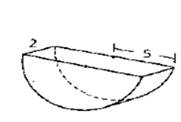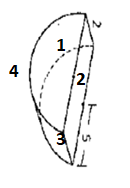
Geometry For Enjoyment And Challenge
91st Edition
ISBN: 9780866099653
Author: Richard Rhoad, George Milauskas, Robert Whipple
Publisher: McDougal Littell
expand_more
expand_more
format_list_bulleted
Concept explainers
Question
Chapter 12.3, Problem 6PSB
To determine
Find the total (including the rectangular face) surface area of a half cylinder.
Expert Solution & Answer
Answer to Problem 6PSB
Explanation of Solution
Given information:
Radius of

Calculation
It is given that,

Surface area of rectangle,
Total Area,
Hence, total area is
Chapter 12 Solutions
Geometry For Enjoyment And Challenge
Ch. 12.1 - Prob. 1PSACh. 12.1 - Prob. 2PSACh. 12.1 - Prob. 3PSACh. 12.1 - Prob. 4PSACh. 12.1 - Prob. 5PSACh. 12.1 - Prob. 6PSBCh. 12.1 - Prob. 7PSBCh. 12.1 - Prob. 8PSBCh. 12.1 - Prob. 9PSCCh. 12.1 - Prob. 10PSC
Ch. 12.1 - Prob. 11PSCCh. 12.2 - Prob. 1PSACh. 12.2 - Prob. 2PSACh. 12.2 - Prob. 3PSACh. 12.2 - Prob. 4PSACh. 12.2 - Prob. 5PSACh. 12.2 - Prob. 6PSBCh. 12.2 - Prob. 7PSBCh. 12.2 - Prob. 8PSBCh. 12.2 - Prob. 9PSBCh. 12.2 - Prob. 10PSCCh. 12.2 - Prob. 11PSCCh. 12.2 - Prob. 12PSCCh. 12.2 - Prob. 13PSCCh. 12.3 - Prob. 1PSACh. 12.3 - Prob. 2PSACh. 12.3 - Prob. 3PSACh. 12.3 - Prob. 4PSACh. 12.3 - Prob. 5PSACh. 12.3 - Prob. 6PSBCh. 12.3 - Prob. 7PSBCh. 12.3 - Prob. 8PSBCh. 12.3 - Prob. 9PSBCh. 12.3 - Prob. 10PSBCh. 12.3 - Prob. 11PSBCh. 12.3 - Prob. 12PSCCh. 12.3 - Prob. 13PSCCh. 12.3 - Prob. 14PSCCh. 12.4 - Prob. 1PSACh. 12.4 - Prob. 2PSACh. 12.4 - Prob. 3PSACh. 12.4 - Prob. 4PSACh. 12.4 - Prob. 5PSACh. 12.4 - Prob. 6PSACh. 12.4 - Prob. 7PSBCh. 12.4 - Prob. 8PSBCh. 12.4 - Prob. 9PSBCh. 12.4 - Prob. 10PSBCh. 12.4 - Prob. 11PSBCh. 12.4 - Prob. 12PSBCh. 12.4 - Prob. 13PSBCh. 12.4 - Prob. 14PSBCh. 12.4 - Prob. 15PSBCh. 12.4 - Prob. 16PSBCh. 12.4 - Prob. 17PSBCh. 12.4 - Prob. 18PSBCh. 12.4 - Prob. 19PSCCh. 12.4 - Prob. 20PSCCh. 12.4 - Prob. 21PSCCh. 12.4 - Prob. 22PSCCh. 12.5 - Prob. 1PSACh. 12.5 - Prob. 2PSACh. 12.5 - Prob. 3PSACh. 12.5 - Prob. 4PSACh. 12.5 - Prob. 5PSACh. 12.5 - Prob. 6PSACh. 12.5 - Prob. 7PSACh. 12.5 - Prob. 8PSBCh. 12.5 - Prob. 9PSBCh. 12.5 - Prob. 10PSBCh. 12.5 - Prob. 11PSBCh. 12.5 - Prob. 12PSBCh. 12.5 - Prob. 13PSBCh. 12.5 - Prob. 14PSBCh. 12.5 - Prob. 15PSBCh. 12.5 - Prob. 16PSBCh. 12.5 - Prob. 17PSCCh. 12.5 - Prob. 18PSCCh. 12.5 - Prob. 19PSCCh. 12.5 - Prob. 20PSCCh. 12.6 - Prob. 1PSACh. 12.6 - Prob. 2PSACh. 12.6 - Prob. 3PSACh. 12.6 - Prob. 4PSACh. 12.6 - Prob. 5PSACh. 12.6 - Prob. 6PSBCh. 12.6 - Prob. 7PSBCh. 12.6 - Prob. 8PSBCh. 12.6 - Prob. 9PSBCh. 12.6 - Prob. 10PSBCh. 12.6 - Prob. 11PSBCh. 12.6 - Prob. 12PSCCh. 12.6 - Prob. 13PSCCh. 12.6 - Prob. 14PSCCh. 12.6 - Prob. 15PSCCh. 12.6 - Prob. 16PSCCh. 12.6 - Prob. 17PSDCh. 12.6 - Prob. 18PSDCh. 12 - Prob. 1RPCh. 12 - Prob. 2RPCh. 12 - Prob. 3RPCh. 12 - Prob. 4RPCh. 12 - Prob. 5RPCh. 12 - Prob. 6RPCh. 12 - Prob. 7RPCh. 12 - Prob. 8RPCh. 12 - Prob. 9RPCh. 12 - Prob. 10RPCh. 12 - Prob. 11RPCh. 12 - Prob. 12RPCh. 12 - Prob. 13RPCh. 12 - Prob. 14RPCh. 12 - Prob. 15RPCh. 12 - Prob. 16RPCh. 12 - Prob. 17RPCh. 12 - Prob. 18RPCh. 12 - Prob. 19RPCh. 12 - Prob. 20RPCh. 12 - Prob. 21RPCh. 12 - Prob. 22RPCh. 12 - Prob. 1CRCh. 12 - Prob. 2CRCh. 12 - Prob. 3CRCh. 12 - Prob. 4CRCh. 12 - Prob. 5CRCh. 12 - Prob. 6CRCh. 12 - Prob. 7CRCh. 12 - Prob. 8CRCh. 12 - Prob. 9CRCh. 12 - Prob. 10CRCh. 12 - Prob. 11CRCh. 12 - Prob. 12CRCh. 12 - Prob. 13CRCh. 12 - Prob. 14CRCh. 12 - Prob. 15CRCh. 12 - Prob. 16CRCh. 12 - Prob. 17CRCh. 12 - Prob. 18CRCh. 12 - Prob. 19CRCh. 12 - Prob. 20CRCh. 12 - Prob. 21CRCh. 12 - Prob. 22CRCh. 12 - Prob. 23CRCh. 12 - Prob. 24CRCh. 12 - Prob. 25CRCh. 12 - Prob. 26CRCh. 12 - Prob. 27CRCh. 12 - Prob. 28CRCh. 12 - Prob. 29CRCh. 12 - Prob. 30CRCh. 12 - Prob. 31CRCh. 12 - Prob. 32CRCh. 12 - Prob. 33CRCh. 12 - Prob. 34CRCh. 12 - Prob. 35CRCh. 12 - Prob. 36CRCh. 12 - Prob. 37CRCh. 12 - Prob. 38CRCh. 12 - Prob. 39CRCh. 12 - Prob. 40CRCh. 12 - Prob. 41CRCh. 12 - Prob. 42CR
Additional Math Textbook Solutions
Find more solutions based on key concepts
Derivative Calculations
In Exercises 112, find the first and second derivatives.
3. s = 5t3 – 3t5
University Calculus: Early Transcendentals (4th Edition)
In how many ways can 3 novels. 2 mathematics books, and 1 chemistry book be arranged on a bookshelf if
a. the ...
A First Course in Probability (10th Edition)
CHECK POINT 1 Find a counterexample to show that the statement The product of two two-digit numbers is a three-...
Thinking Mathematically (6th Edition)
Fill in each blank so that the resulting statement is true. An equation that expresses a relationship between t...
Algebra and Trigonometry (6th Edition)
76. Dew Point and Altitude The dew point decreases as altitude increases. If the dew point on the ground is 80°...
College Algebra with Modeling & Visualization (5th Edition)
Knowledge Booster
Learn more about
Need a deep-dive on the concept behind this application? Look no further. Learn more about this topic, geometry and related others by exploring similar questions and additional content below.Similar questions
- To approximate the length of a marsh, a surveyor walks x = 400 meters from point A to point B. Then, the surveyor turns 75° and walks 220 meters to point C (see figure). Approximate the length AC of the marsh. (Round your answer to one decimal place.) m C B 75° 220 m x marrow_forward. The students who attend Memorial High School have a wide variety of extra-curricular activities to choose from in the after-school program. Students are 38% likely to join the dance team; 18% likely to participate in the school play; 42% likely to join the yearbook club; and 64% likely to join the marching band. Many students choose to participate in multiple activities. Students have equal probabilities of being freshmen, sophomores, juniors, or seniors.What is the probability of the union of being either a freshman or senior? 0.07 0.44 0.50 0.25arrow_forwardWhich angles are complementary to each other? Select all that apply. 3 2 4 in 5 1 Z1 and 23 Z1 and 25 22 and 23 Z2 and 25 Submitarrow_forward
- Which angles are adjacent to each other? Select all that apply. 3 2 4 67 5 8 11 10 12 12 9 27 and 28 Z9 and 12 Z3 and 24 Z10 and Z11arrow_forwardIf the arc length of NMP is 11π, what is the length of MNP expressed in terms of πT? M N 5 44% ○ A. 54π OB. 108π P О с. 103 18 O D. 108arrow_forwardGiven: Circle J 2 What is the value of y? A. 38 C. 68 B. 50 D. 92arrow_forward
- Find the surface area of the regular pyramid. yd2arrow_forward5:00 PM Sat May 3 deltamath.com DeltaMath Given: ABBC and D is the midpoint of AC. Prove: ABD ≈ ACBD. ← Back to Home Deltamath Regents Review Week 3 Due: May 9 at 8:00 PM Grade: 97% Step Statement AB ≈ BC Reason 1 Given D is the midpoint of AC 2 BD BD 3 ADDC Calculating Volume (Mixed) Volume of Oblique Solids Volume, Density, and Unit 5 4 AABC is an isosceles triangle ZAZC Conversions (Level 1) Triangle Congruence Criteria try ZAD =/ DC Basic Triangle Proofs (Congruence Only - No CPCTC) Triangle Proofs (Reasons Only) Calculator Aseret Martinez Domi... Log Out Reflexive Property A midpoint divides a segment into two congruent segments The triangle has two congruent sides In a triangle, angles opposite of congruent sides are congruent An angle bisector divides an angle into two congruent angles B * A Ꭰ Note: the segment AC is a straight segment. 86%arrow_forwardLANDMARKS Stonehenge is a British landmark made of huge stones arranged in a circular pattern that reflects the movements of Earth and the moon. The diagram shows that the angle formed by the north/south axis and the line aligned from the station stone to the northmost moonrise position measures 23.5°. a. Find measure of arc BC. b. Is arc ABC semicircle? Explain. c. If the circle measures about 100 feet across, approximately how far would you walk around the circle from point B to point sarsen circle B station stone trilithons horseshoe 71° 23.5° farthest north moonrise Sarrow_forward
- find the value of each variablearrow_forwardName: Date: Bell: Unit 11: Volume & Surface Area Homework 2: Area of Sectors Directions: Find the area of each shaded sector. Round to the hundredths place. 1. GH 11 in 2. KL 20 ft H F 64 G L 119 M K 3. BA 6.5 cm 4. YZ 14.2 m B 23 X 87° Y Z 5. KL = 27.1 mm J 32 L X:360-32.1 K A-3 360 7. BD 18 cm E 136 B X=32.8 127.0 (271) A: 069.13 Amm² 19=2102.13 A-136 360.16912 A:300cm² A=96.13 6. PQ = 2.8 in P R 311° 8. WZ 5.3 km V = Z 108 W D 9. HK = 25 ft G H KO 26 X 10. SR 26 m = S 73 T R Gina Wilson (All Things Algebarrow_forward538 Chapter 13 12. Given: Points E(-4, 1), F(2, 3), G(4, 9), and H(-2, 7) a. Show that EFGH is a rhombus. b. Use slopes to verify that the diagonals are perpendicular. 13. Given: Points R(-4, 5), S(-1, 9), T(7, 3) and U(4, -1) a. Show that RSTU is a rectangle. b. Use the distance formula to verify that the diagonals are congruent. 14. Given: Points N(-1, -5), O(0, 0), P(3, 2), and 2(8, 1) a. Show that NOPQ is an isosceles trapezoid. b. Show that the diagonals are congruent. Decide what special type of quadrilateral HIJK is. Then prove that your answer is correct. 15. H(0, 0) 16. H(0, 1) 17. H(7, 5) 18. H(-3, -3) I(5, 0) I(2,-3) 1(8, 3) I(-5, -6) J(7, 9) K(1, 9) J(-2, -1) K(-4, 3) J(0, -1) K(-1, 1) J(4, -5) K(6,-2) 19. Point N(3, - 4) lies on the circle x² + y² = 25. What is the slope of the (Hint: Recall Theorem 9-1.) - line that is tangent to the circle at N? 20. Point P(6, 7) lies on the circle (x + 2)² + (y − 1)² = 100. What is the slope of the line that is tangent to the circle at…arrow_forward
arrow_back_ios
SEE MORE QUESTIONS
arrow_forward_ios
Recommended textbooks for you
 Elementary Geometry For College Students, 7eGeometryISBN:9781337614085Author:Alexander, Daniel C.; Koeberlein, Geralyn M.Publisher:Cengage,
Elementary Geometry For College Students, 7eGeometryISBN:9781337614085Author:Alexander, Daniel C.; Koeberlein, Geralyn M.Publisher:Cengage, Elementary Geometry for College StudentsGeometryISBN:9781285195698Author:Daniel C. Alexander, Geralyn M. KoeberleinPublisher:Cengage Learning
Elementary Geometry for College StudentsGeometryISBN:9781285195698Author:Daniel C. Alexander, Geralyn M. KoeberleinPublisher:Cengage Learning

Elementary Geometry For College Students, 7e
Geometry
ISBN:9781337614085
Author:Alexander, Daniel C.; Koeberlein, Geralyn M.
Publisher:Cengage,

Elementary Geometry for College Students
Geometry
ISBN:9781285195698
Author:Daniel C. Alexander, Geralyn M. Koeberlein
Publisher:Cengage Learning
The surface area and volume of cone, cylinder, prism and pyramid; Author: AtHome Tuition;https://www.youtube.com/watch?v=SlaQmaJCOt8;License: Standard YouTube License, CC-BY